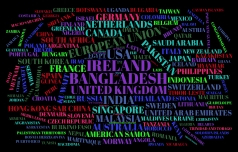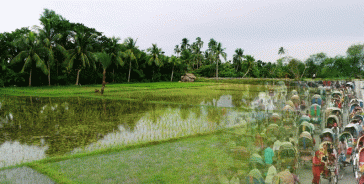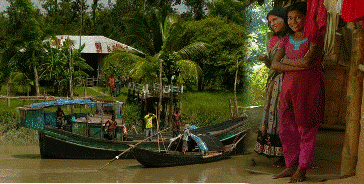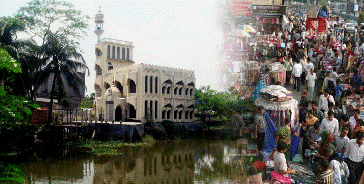 In an article reproduced on the website of Grameen Bank, Bangladesh: a country that contradicts the cliché, the author, Frédéric Bobin, writes that Bangladesh goes against the clichéd image of a Muslim country, when it comes to the position of women in society. He attributes this to the secular dimension of the founding of the state, when cultural nationalism played a larger part than Islam in unifying the new country (see post 14 and post 37). Furthermore, during and following the war, many women, whose husbands, fathers and brothers were amongst the 3 million war-dead, took responsibility for the men’s affairs and were thereby propelled into the public sphere.
In an article reproduced on the website of Grameen Bank, Bangladesh: a country that contradicts the cliché, the author, Frédéric Bobin, writes that Bangladesh goes against the clichéd image of a Muslim country, when it comes to the position of women in society. He attributes this to the secular dimension of the founding of the state, when cultural nationalism played a larger part than Islam in unifying the new country (see post 14 and post 37). Furthermore, during and following the war, many women, whose husbands, fathers and brothers were amongst the 3 million war-dead, took responsibility for the men’s affairs and were thereby propelled into the public sphere.
The fact that Bangladesh has had a female prime minister for the last 20 years or so, alternating between the present Sheikh Hasina and the leader of the opposition Khaleda Zia, is often held up as testament to the empowerment of women here. However, both derived their legitimacy through male relatives as you will have read elsewhere in this blog. Today, in addition to the prime minister, there are a number of women holding important ministries. Officially, the government is committed to equality and increased participation for women in national and local government. This is reflected in the national poverty reduction strategy, which highlights the importance of women’s rights for development. However, many contend that civil society, micro-finance and organisations like BRAC and Grameen (see post 8) have played a much more fundamental and meaningful role in progressing women’s rights than any politician, male or female. There is an animated women’s movement in Bangladesh that continues to promote gender equality by advocating for changes in laws and policies. (For example, there is the work of Angela Gomes and her organisation in Jessore, for which she won a 1999 Ramon Magsaysay Award. Incidentally, a previous recipient of this award in 1978, Tahrunnesa Ahmed Abdullah, was a respected advocate and international voice in the field of women and rural development. The Magsaysay award recognised her contribution in ‘leading rural Bangladeshi Muslim women from the constraints of purdah toward more equal citizenship and fuller family responsibility’.)
Widespread social and cultural change, albeit slow, is nonetheless evident. Deeply entrenched cultural views, relating to appropriate roles for women in both the public and private spheres, are being challenged. There are more women working outside the home now e.g. in the garment industry (see post 52), and this has resulted in a shift in family dynamics and perceptions. Significant progress has been made in relation to closing the gender gap in school enrolment (see post 35).
While, unfortunately, I didn’t get to know as many women as I did men (see post 39), almost every day I come across stories that attest to the independence, strength and vibrancy of women throughout Bangladesh – be they civil rights activists, academics, writers, artists, local government representatives, development workers, business women, garment workers or rural farmers. I could write the entire blog post on the many inspirational women in the public sphere in Bangladesh – past and present – many of whom I have made reference to in other parts of this blog.
Living in Dhaka, I am aware of the disparity in the lives of women from different social groups. The small, urban middle-class live very much like their western counterparts. For example, there were times when I found myself in cosmopolitan cafés in the wealthier suburbs of Dhaka, surrounded by women in jeans sipping cappuccinos while I, the only foreigner, was dressed in the traditional, local shalwar-kameez. A very bizarre feeling! However, in other parts of the city, and in rural Bangladesh, I would rarely see women in public places e.g. in the bazars and tea stalls at night.
It is important to acknowledge the strength and vitality of women in Bangladesh, as outlined above. Many articles, written by western observers, about women in Bangladesh (and other countries), are often condescending (albeit unintentionally) in their portrayals of women as victims only. This is not to deny that the challenges remaining are manifold, as is evident in gender equality indices e.g. the UNDP development indices (2009). For Bangladesh, the gender-related development Index (GDI) is lower than the human development index (HDI), indicating that an aggregated index masks gender inequalities. Of the 155 countries for which both indices could be calculated, 100 countries showed less disparity than Bangladesh. On the gender empowerment measure (GEM), which considers whether women are active in public and economic life, Bangladesh ranks 108th of 109 countries. Bangladesh is ranked 63rd out of 86 in the OECD (Organisation for Economic Cooperation and Development) Social Institutions and Gender Index. You can read about the variables they use on their website, together with their explanation of the ranking for Bangladesh.
There are a number of reasons for these low scores. It is still a challenge for women in politics to influence public decision-making, due to both lack of experience and continuing resistance from male colleagues. While access to education has improved, as outlined earlier, learning outcomes are poor, particularly for girls. Economic opportunities for women continue to be limited by factors such as discrimination in the labour market; limited access to training; high illiteracy levels; and very heavy household work burdens, due to deficiencies in basic services. Most women work at the low wage end of the formal sector or else in the informal sector. Close to half of all farmers in Bangladesh are women, and 15% of rural families are headed by women whose husbands have died, divorced or abandoned them. A significant number of women farmers are unable to access fertiliser, cash assistance and other government subsidies intended for farmers, because the land they work is registered in their husbands’ names. (It is estimated that half of all farmers in the developing world are women and research has shown that when women farmers have access to the same resources as men, they can produce 30% more food.) Finally, the high levels of violence against women, and fear of violence, both in families and communities, impedes mobility and quality of life (see below).
There are over 82 million women in Bangladesh (based on 50% of the total population). For the majority of these women (including adolescent girls), life is characterised by inequality and subordination within the family and society. Too many women suffer horrific acts of violence, as outlined below. While most of these crimes are ‘illegal’ or ‘banned’, the legal system is ineffective. Perpetrators of this violence often escape being brought to justice. Furthermore, many uneducated women remain unaware of the laws and/or of their rights.
In addition to the discrimination against women outlined above, below are examples of some of the more shocking crimes that many women in Bangladesh fall victim to. Daily reports in the papers attest to the frequency and ferocity of such crimes.
- Dowry-related violence. Violence frequently erupts in relation to disputes over dowry, the marriage custom relating to payment of money and goods by a woman’s family to her new husband’s family. Abuse, torture and even murder of the new wife have resulted from such violence. This clip from Aljazeera highlights the issue of dowry-related violence.
- Religious-related violence. There is a sizeable Islamic group against equal rights for women in Bangladesh. This was evidenced in the riots in 2008 in Dhaka that followed the announcement of the long-overdue Women’s Development Policy. The demonstrators considered the policy to be ‘anti-Koran’.
- Religious ‘justice’. Related to the above point there are daily blood-curdling reports in the papers of extrajudicial punishments called ‘fatwas’. These are religious edicts under Islamic Sharia law. You can read the horrific story of 14-year old Hena, who, after surviving rape, was labelled an adulteress and sentenced by local elders and clerics to 100 lashes. She was beaten to death. Despite the anti-fatwa rhetoric, including a call from the president, the practice continues.
- Acid attacks. Every second day in Bangladesh there is an ‘acid attack’ on a woman. In this heinous crime, acid, usually aimed at the face, burns through skin and bone, leading to permanent disfigurement. Have a look at this brief YouTube clip to see some of the ‘reasons’ behind attacks, and some work that is being done with survivors. You can read about Matiur Rahman’s/Prothom Alo’s campaign against acid violence here, for which Rahman won a 2005 Ramon Magsaysay Award.
- Sexual harassment and sexual abuse. When I first read the term ‘eve-teasing’ in the papers here I thought it was a mistake. Then I began to see it more and more and I realised that the same term is also used in other parts of Asia e.g. India and Pakistan. ‘Eve-teasing’ is a euphemism used to denote verbal and/or physical sexual harassment and abuse. Every time I read the word I feel angry on so many levels. First of all there’s the mythical Eve, from Abrahamic religions, used as justification for the suppression of women’s rights, due to her supposed responsibility for the Fall of Man. Then there’s the word ‘teasing’ with its playful connotations. This is hardly an appropriate term to describe the sexual violence that destroys the lives of so many women in Bangladesh and elsewhere. A disturbing number of young women in Bangladesh commit suicide as a result of such serious harassment e.g. the 13-year old girl nick-named Pinky.
- Polygamy. Polygamy is legal in Bangladesh. Though the practice is considered outdated and has decreased in the past 50 years in urban areas, it is still prevalent in many rural areas (see post 50). The law permits Muslim men to marry up to four women, conditional (supposedly) on the consent of prior wives.
Writing about the above discrimination and abuse against women fills me with sadness. From a young age I think I was a natural feminist, before I even knew what the word meant. I could never understand why the idea of equal opportunities and outcomes for men and women would even need to be debated. I have outlined a litany of abuses in Bangladesh, but of course discrimination exists throughout the world to a greater or lesser extent.
Catherine MacKinnon, in her book, ‘Are Women Human?’, ends with an essay called ‘Women’s September 11’. In it she points out that roughly the same number of women are murdered by men in the US each year as were killed in the Twin Towers (between 2,800 and 3,000). But these killings provoke no parallel war on terror. She argues that if the rights that we grant to all humans are not granted to women, then that implies that they have sub-human status. [It is also the case that most victims (as well as most perpetrators) in homicides in the US are male, but it is more likely for female victims to be killed by an intimate or family member.]
Even when much of the overt, obvious inequality – like that described in this post – is addressed, there remains a sort of socially conditioned, covert misogyny. This is evidenced in many of our institutions/organisations and in the often unconscious remarks and subtly, sexist constructs and attitudes that attest to an unquestioned assumption of the innate inferiority of women. (P.S. This article, ‘Misogyny’, by Matt Gemmell captures some of these instances well.) (P.P.S. Later. Unfortunately, this link no longer works and I have failed to find an alternative.)
I will end with this quote from Philip Pullman. It captures the multi-faceted nature of human identity – of which gender is but one ‘property’. (The complexity and ambiguity rings very true indeed.)
I feel with some passion that what we truly are is private, and almost infinitely complex, and ambiguous, and both external and internal, and double- or triple- or multiply natured, and largely mysterious even to ourselves; and furthermore that what we are is only part of us, because identity, unlike “identity”, must include what we do. And I think that to find oneself and every aspect of this complexity reduced in the public mind to one property that apparently subsumes all the rest (“gay”, “black”, “Muslim”, whatever) is to be the victim of a piece of extraordinary intellectual vulgarity.
I wonder if there will ever be a day when we recognise and respect the full humanity of all human beings; when we will act as though all lives have equal value. Not in my lifetime I would think, though undoubtedly the world would be a better place. One of the things that attracted me about my work placement in Bangladesh was the possibility of contributing to work in the area of gender equality. Unfortunately, however, implementing my related objectives in this regard is proving problematic (see posts 25, 48).

 On March 15th 2009 I left Ireland to spend 13 months in Bangladesh as a
On March 15th 2009 I left Ireland to spend 13 months in Bangladesh as a 







 I am especially conscious that I am writing about an Eastern culture from the perspective of a Western observer. The opinions expressed are my own - unless otherwise stated. Should you perceive inaccuracy or misrepresentation, in this regard or in any other, or you would like to add something, I would welcome your observations. Leave a comment below the relevant post(s).
I am especially conscious that I am writing about an Eastern culture from the perspective of a Western observer. The opinions expressed are my own - unless otherwise stated. Should you perceive inaccuracy or misrepresentation, in this regard or in any other, or you would like to add something, I would welcome your observations. Leave a comment below the relevant post(s).
This is good and interesting. But I think you need to include child marriage in highlights. My English is not very good but look here: https://en.wikipedia.org/wiki/Women_in_Bangladesh.
Thank you for commenting Anika. You are right. I did refer to young women/children in different circumstances, but I should have highlighted it. This Wikipedia link is informative and updates the subject too. Thank you again.